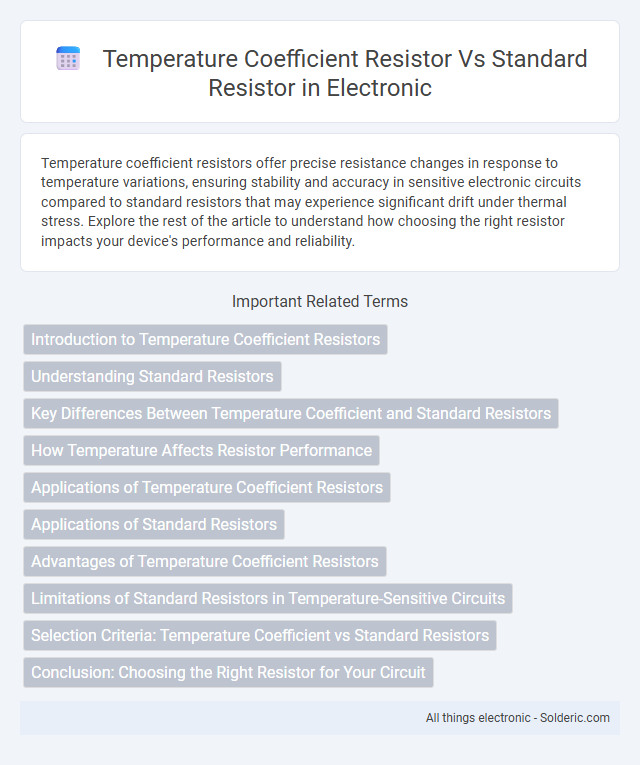Temperature coefficient resistors offer precise resistance changes in response to temperature variations, ensuring stability and accuracy in sensitive electronic circuits compared to standard resistors that may experience significant drift under thermal stress. Explore the rest of the article to understand how choosing the right resistor impacts your device's performance and reliability.
Comparison Table
| Feature | Temperature Coefficient Resistor | Standard Resistor |
|---|---|---|
| Temperature Stability | Highly stable with defined temperature coefficient (e.g., +-5 ppm/degC) | Lower stability; significant resistance change with temperature |
| Resistance Accuracy | High precision, used in sensitive circuits | Standard accuracy, typically +-1% to +-5% |
| Applications | Precision measurement, instrumentation, temperature compensation | General-purpose electronics and low-cost applications |
| Cost | Higher cost due to specialized materials and manufacturing | Lower cost, widely available |
| Material | Metal film, metal foil, or other low TCR materials | Carbon film, metal oxide, or wirewound |
| Temperature Coefficient of Resistance (TCR) | Low TCR (e.g., +-1 to +-50 ppm/degC) | Higher TCR (e.g., +-100 to +-5000 ppm/degC) |
Introduction to Temperature Coefficient Resistors
Temperature coefficient resistors are specially designed to maintain consistent resistance values despite temperature fluctuations, measured by their temperature coefficient of resistance (TCR) expressed in parts per million per degree Celsius (ppm/degC). Standard resistors typically have higher TCR values, resulting in more significant resistance changes when exposed to varying temperatures, which can affect circuit accuracy. Applications requiring precise resistance stability, such as precision instrumentation and temperature-sensitive electronics, commonly use low TCR temperature coefficient resistors to ensure optimal performance.
Understanding Standard Resistors
Standard resistors typically have a temperature coefficient of resistance (TCR) ranging from +-100 to +-200 ppm/degC, indicating how much their resistance changes with temperature fluctuations. Unlike precision temperature coefficient resistors, standard resistors may exhibit greater variability in resistance under different thermal conditions, affecting circuit stability and accuracy. Understanding the TCR of standard resistors is crucial for applications where temperature-induced deviations can impact overall electronic performance.
Key Differences Between Temperature Coefficient and Standard Resistors
Temperature coefficient resistors (TCR) are specifically designed to maintain resistance stability across a wide temperature range, featuring precise temperature coefficient values often measured in ppm/degC. Standard resistors lack this controlled temperature behavior, exhibiting greater resistance variation with temperature changes, which can affect circuit accuracy. Understanding your application's sensitivity to temperature fluctuations helps determine if a temperature coefficient resistor is necessary for improved performance and reliability.
How Temperature Affects Resistor Performance
Temperature coefficient resistors (TCR) maintain stable resistance values by minimizing changes caused by temperature fluctuations, ensuring precision in sensitive electronic circuits. Standard resistors, lacking temperature compensation, often exhibit significant resistance variation as temperature shifts, potentially leading to circuit inaccuracies. Understanding TCR ratings helps engineers select components that sustain consistent performance under varying thermal conditions.
Applications of Temperature Coefficient Resistors
Temperature coefficient resistors are essential in precision applications where resistance stability under varying temperatures is crucial, such as in temperature sensors, compensation circuits, and calibration devices. Unlike standard resistors, they are specifically designed to minimize resistance changes due to temperature fluctuations, ensuring accurate and reliable measurements in industrial and scientific environments. Your choice of a temperature coefficient resistor enhances performance in systems requiring precise thermal management and consistent electrical characteristics.
Applications of Standard Resistors
Standard resistors are widely used in general electronic circuits where precise temperature stability is not critical, such as in consumer electronics, power supplies, and signal processing. They provide reliable resistance values for current limiting, voltage division, and biasing applications without the need for tight temperature control. Typical applications include circuit board assemblies, LED drivers, and audio equipment where moderate environmental variations are expected.
Advantages of Temperature Coefficient Resistors
Temperature coefficient resistors offer enhanced stability and precision by minimizing resistance changes in response to temperature fluctuations. Your electronic circuits benefit from improved accuracy and reliability, particularly in environments with varying thermal conditions. These resistors reduce errors caused by temperature variations, ensuring consistent performance compared to standard resistors.
Limitations of Standard Resistors in Temperature-Sensitive Circuits
Standard resistors exhibit significant resistance variation with temperature changes, often characterized by a high temperature coefficient of resistance (TCR), making them unreliable in temperature-sensitive circuits. These variations can cause inaccuracies and unstable performance in precision applications such as sensor signal conditioning and temperature compensation. Using temperature coefficient resistors with low or zero TCR mitigates these issues, ensuring your circuit maintains consistent resistance values across varying temperatures.
Selection Criteria: Temperature Coefficient vs Standard Resistors
Temperature coefficient resistors are selected for applications requiring precise resistance stability over varying temperatures, exhibiting minimal resistance change per degree Celsius, typically measured in ppm/degC. Standard resistors, with higher temperature coefficients, may experience significant resistance fluctuations, making them less suitable for temperature-sensitive circuits. The choice hinges on the operating temperature range and the allowable resistance tolerance to ensure optimal performance and reliability.
Conclusion: Choosing the Right Resistor for Your Circuit
Selecting the right resistor hinges on understanding the impact of temperature on resistance stability; temperature coefficient resistors (TCR) offer superior accuracy by minimizing resistance variation with temperature changes, essential for precision circuits. Standard resistors, while cost-effective, exhibit higher resistance fluctuations under varying thermal conditions, making them suitable for non-critical applications. Engineers prioritize TCR resistors in environments demanding consistent performance and standard resistors where temperature-induced resistance shifts are negligible.
Temperature coefficient resistor vs standard resistor Infographic

 solderic.com
solderic.com